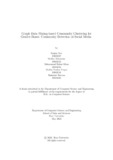| dc.contributor.advisor | Alam, Md. Golam Rabiul | |
| dc.contributor.author | Dev, Sanjoy | |
| dc.contributor.author | Tabassum, Maliha | |
| dc.contributor.author | Khan, Mohammad Rahat | |
| dc.contributor.author | Hoque, Maliha Bushra | |
| dc.contributor.author | Fatema, Basharat | |
| dc.date.accessioned | 2023-12-07T06:37:49Z | |
| dc.date.available | 2023-12-07T06:37:49Z | |
| dc.date.copyright | 2023 | |
| dc.date.issued | 2023-05 | |
| dc.identifier.other | ID 19101507 | |
| dc.identifier.other | ID 19101212 | |
| dc.identifier.other | ID 20101616 | |
| dc.identifier.other | ID 19101543 | |
| dc.identifier.other | ID 20101600 | |
| dc.identifier.uri | http://hdl.handle.net/10361/21937 | |
| dc.description | This thesis is submitted in partial fulfillment of the requirements for the degree of Bachelor of Science in Computer Science, 2023. | en_US |
| dc.description | Cataloged from PDF version of thesis. | |
| dc.description | Includes bibliographical references (pages 38-40). | |
| dc.description.abstract | One of the alarming and uprising issues of the world is gender inequality in recent decades. It is a widespread problem that affects people all around the world, albeit its manifestations and severity vary depending on society and culture. The research gives a thorough investigation of gender bias in online social networks utilizing community clustering and graph data mining approaches. The research methodology includes gathering Twitter data about gender bias using some specific keywords and utilizing networkX to build a graph representation. To divide the graph into different communities, three well-known community detection algorithms—Louvain, Girvan-Newman, and Walktrap—are used. These algorithms’ effectiveness is assessed using extrinsic metrics like V-measure and normalized mutual information (NMI), as well as intrinsic metrics like F1 score, recall, and precision. The characteristics of the selected communities are also studied using descriptive statistics and visualization methods. Four communities on gender biasness: Male Biased, Female Biased, Feminism and Neutral people are presented here. The research advances knowledge of gender biases in online social networks and can guide initiatives to advance equality and inclusivity. The goal of this study is to create a solid framework for identifying and examining communities that show neutrality, feminism, neutrality, and male and female prejudice. | en_US |
| dc.description.statementofresponsibility | Sanjoy Dev | |
| dc.description.statementofresponsibility | Maliha Tabassum | |
| dc.description.statementofresponsibility | Mohammad Rahat Khan | |
| dc.description.statementofresponsibility | Maliha Bushra Hoque | |
| dc.description.statementofresponsibility | Basharat Fatema | |
| dc.format.extent | 40 pages | |
| dc.language.iso | en | en_US |
| dc.publisher | Brac University | en_US |
| dc.rights | Brac University theses are protected by copyright. They may be viewed from this source for any purpose, but reproduction or distribution in any format is prohibited without written permission. | |
| dc.subject | Community clustering | en_US |
| dc.subject | Graph data mining | en_US |
| dc.subject | Gender bias | en_US |
| dc.subject | Social network analysis | en_US |
| dc.subject | Online social networks | en_US |
| dc.subject | Twitter | en_US |
| dc.subject.lcsh | Data mining | |
| dc.subject.lcsh | Graph theory--Data processing | |
| dc.subject.lcsh | Machine learning | |
| dc.subject.lcsh | Artificial intelligence | |
| dc.title | Graph data mining-based community clustering for gender-biased community detection of social media | en_US |
| dc.type | Thesis | en_US |
| dc.contributor.department | Department of Computer Science and Engineering, Brac University | |
| dc.description.degree | B.Sc. in Computer Science and Engineering | |

